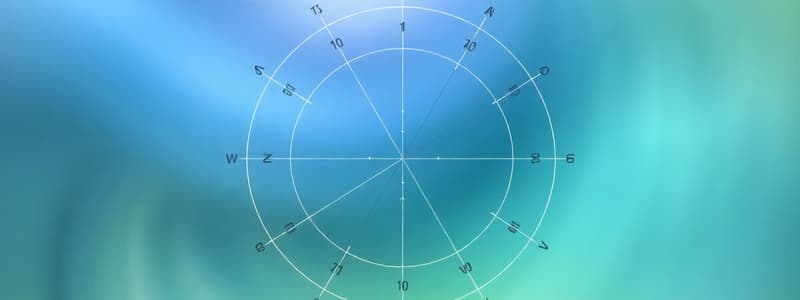Podcast
Questions and Answers
What does radial acceleration represent in plane polar coordinates?
What does radial acceleration represent in plane polar coordinates?
- Acceleration due to a constant angular velocity
- Acceleration due to a change in tangential speed
- The acceleration directed outward from the center of motion
- Acceleration acting towards the center of the circular path (correct)
Which component contributes to the Coriolis acceleration when both r and θ change over time?
Which component contributes to the Coriolis acceleration when both r and θ change over time?
- Constant angular velocity
- Tangential speed change (correct)
- Radial velocity change (correct)
- Centripetal acceleration
In polar coordinates, what does Newton’s law imply about the forces acting in different directions?
In polar coordinates, what does Newton’s law imply about the forces acting in different directions?
- Tangential acceleration is always zero in polar coordinates
- Forces in polar coordinates are equivalent to those in Cartesian coordinates
- Acceleration must always be directed outward from the center
- The form of Newton's law varies across different coordinate systems (correct)
What condition must be met for the Coriolis acceleration to be present?
What condition must be met for the Coriolis acceleration to be present?
What type of motion does a fixed radial distance with a varying angular position imply?
What type of motion does a fixed radial distance with a varying angular position imply?
What results when the tangential speed vθ changes due to a change in radial distance Δr?
What results when the tangential speed vθ changes due to a change in radial distance Δr?
What does the centripetal acceleration act upon during motion in a circular path?
What does the centripetal acceleration act upon during motion in a circular path?
When analyzing the motion in plane polar coordinates, which aspect is NOT covered by the acceleration formula?
When analyzing the motion in plane polar coordinates, which aspect is NOT covered by the acceleration formula?
How is the x-coordinate of the center of mass calculated for a system of particles?
How is the x-coordinate of the center of mass calculated for a system of particles?
In a 3D particle system, what does the position vector of the center of mass represent?
In a 3D particle system, what does the position vector of the center of mass represent?
For a two-particle system positioned at $(x_1, y_1)$ and $(x_2, y_2)$, how would you express the y-coordinate of the center of mass?
For a two-particle system positioned at $(x_1, y_1)$ and $(x_2, y_2)$, how would you express the y-coordinate of the center of mass?
When considering a system of n particles, which expression is correct for the z-coordinate of the center of mass?
When considering a system of n particles, which expression is correct for the z-coordinate of the center of mass?
If you have a 3-particle system, which formula correctly represents the x-coordinate of the center of mass?
If you have a 3-particle system, which formula correctly represents the x-coordinate of the center of mass?
What does the position vector in polar coordinates represent?
What does the position vector in polar coordinates represent?
What is the primary characteristic of velocity in plane polar coordinates?
What is the primary characteristic of velocity in plane polar coordinates?
In the context of polar coordinates, which variable indicates the radial distance?
In the context of polar coordinates, which variable indicates the radial distance?
What is the expression for the velocity vector in polar coordinates?
What is the expression for the velocity vector in polar coordinates?
When is the radial velocity component constant in polar coordinates?
When is the radial velocity component constant in polar coordinates?
In the given equations, what does the notation $ṙ$ signify?
In the given equations, what does the notation $ṙ$ signify?
Which of the following correctly describes tangential velocity in polar coordinates?
Which of the following correctly describes tangential velocity in polar coordinates?
Which scenario qualifies as a combination of radial and tangential motion?
Which scenario qualifies as a combination of radial and tangential motion?
What are the coordinates used in the Cartesian coordinate system?
What are the coordinates used in the Cartesian coordinate system?
Which coordinate system is described as suitable for circular motion?
Which coordinate system is described as suitable for circular motion?
In the plane polar coordinate system, what does the variable 'r' represent?
In the plane polar coordinate system, what does the variable 'r' represent?
How is the position of a point represented in the plane polar coordinate system?
How is the position of a point represented in the plane polar coordinate system?
Which coordinate system has three dimensions?
Which coordinate system has three dimensions?
In Cartesian coordinates, how are lines of constant x and y represented?
In Cartesian coordinates, how are lines of constant x and y represented?
What does the angle θ represent in the plane polar coordinate system?
What does the angle θ represent in the plane polar coordinate system?
Which of the following is NOT a coordinate system mentioned?
Which of the following is NOT a coordinate system mentioned?
What is the significance of the center of mass being independent of the origin in a system of particles?
What is the significance of the center of mass being independent of the origin in a system of particles?
In terms of mass elements, how is the position of the center of mass calculated?
In terms of mass elements, how is the position of the center of mass calculated?
What happens to the moment of masses about the origin if the center of mass is chosen as the origin?
What happens to the moment of masses about the origin if the center of mass is chosen as the origin?
As N approaches infinity in the continuum limit, how is the expression for the center of mass derived?
As N approaches infinity in the continuum limit, how is the expression for the center of mass derived?
Which of the following equations represents the moment of masses about the origin?
Which of the following equations represents the moment of masses about the origin?
Flashcards are hidden until you start studying
Study Notes
Motion in Polar Coordinates
- Position vector in polar coordinates is represented as ( \vec{r} = r \hat{e_r} ).
- Two cases of motion:
- Radial motion: constant angle ( \theta ), ( \vec{v} = \dot{r} \hat{e_r} ).
- Circular motion: fixed radius ( r ), varying angle ( \theta ), ( \vec{v} = r \dot{\theta} \hat{e_\theta} ).
Acceleration in Polar Coordinates
- Acceleration in polar coordinates is the sum of radial and tangential acceleration.
- The full expression for acceleration: [ \vec{a} = \ddot{r} \hat{e_r} + r \dot{\theta}^2 \hat{e_r} + (r \ddot{\theta} + 2 \dot{r} \dot{\theta}) \hat{e_\theta} ]
- Coriolis acceleration occurs when both ( r ) and ( \theta ) vary with time.
Coriolis Acceleration
- Split into components based on changes in radial velocity and tangential speed.
- Half is due to radial velocity change, and half is related to tangential speed variations.
Newton’s Law in Polar Coordinates
- Newton's laws are not in Cartesian form in polar coordinates.
- For radial direction: [ F_r = m(\ddot{r} - r \dot{\theta}^2) ]
- For tangential direction: [ F_\theta = m(r \ddot{\theta} + 2 \dot{r} \dot{\theta}) ]
Center of Mass in 2D
- For two particles not along the x-axis: [ x_{cm} = \frac{m_1 x_1 + m_2 x_2}{m_1 + m_2}, \quad y_{cm} = \frac{m_1 y_1 + m_2 y_2}{m_1 + m_2} ]
- Important for understanding motion and distribution of mass.
Multi-Particle System Center of Mass
- Center of mass for a system of ( n ) particles in 3D: [ x_{cm} = \frac{\sum m_i x_i}{\sum m_i}, \quad y_{cm} = \frac{\sum m_i y_i}{\sum m_i}, \quad z_{cm} = \frac{\sum m_i z_i}{\sum m_i} ]
Various Coordinate Systems
- Common coordinate systems include:
- Cartesian: defined by ( (x, y) ).
- Plane Polar: defined by ( (r, \theta) ).
- Cylindrical: ( (\rho, \phi, z) ).
- Spherical: ( (r, \theta, \phi) ).
- Cartesian coordinates are frequently used for linear motion.
Relation Between Cartesian and Polar Coordinates
- Position in polar coordinates relates to Cartesian as follows: [ x = r \cos(\theta), \quad y = r \sin(\theta) ]
Motion Analysis in Plane Polar Coordinates
- Velocity has both radial and tangential components: [ \vec{v} = \dot{r} \hat{e_r} + r \dot{\theta} \hat{e_\theta} ]
- Significant when analyzing systems moving in circular paths.
Pseudo Forces in Polar Motion
- In non-inertial frames, a pseudo force is added to modify Newton's laws for motion in polar dynamics.
Studying That Suits You
Use AI to generate personalized quizzes and flashcards to suit your learning preferences.




